Financial Analysis of Hilton Hotel: Performance, Trends, and Ratios
VerifiedAdded on 2023/06/10
|10
|2705
|380
Report
AI Summary
This report provides a comprehensive financial analysis of Hilton Hotel, examining its performance from 2019 to 2020. The analysis includes an executive summary, an introduction to financial management, and detailed financial statements (income statement and balance sheet) with calculated percentage changes. Horizontal ratio analysis is performed on key financial data, including current ratio, quick ratio, and debt-equity ratio, and the trends are discussed to draw conclusions about the company's liquidity, solvency, and profitability. The report also explores the importance and limitations of ratio analysis, highlighting how an understanding of ratio fluctuations is crucial for hotel management decision-making. The conclusion summarizes the decline in sales and its impact on profitability, along with recommendations for improvement.
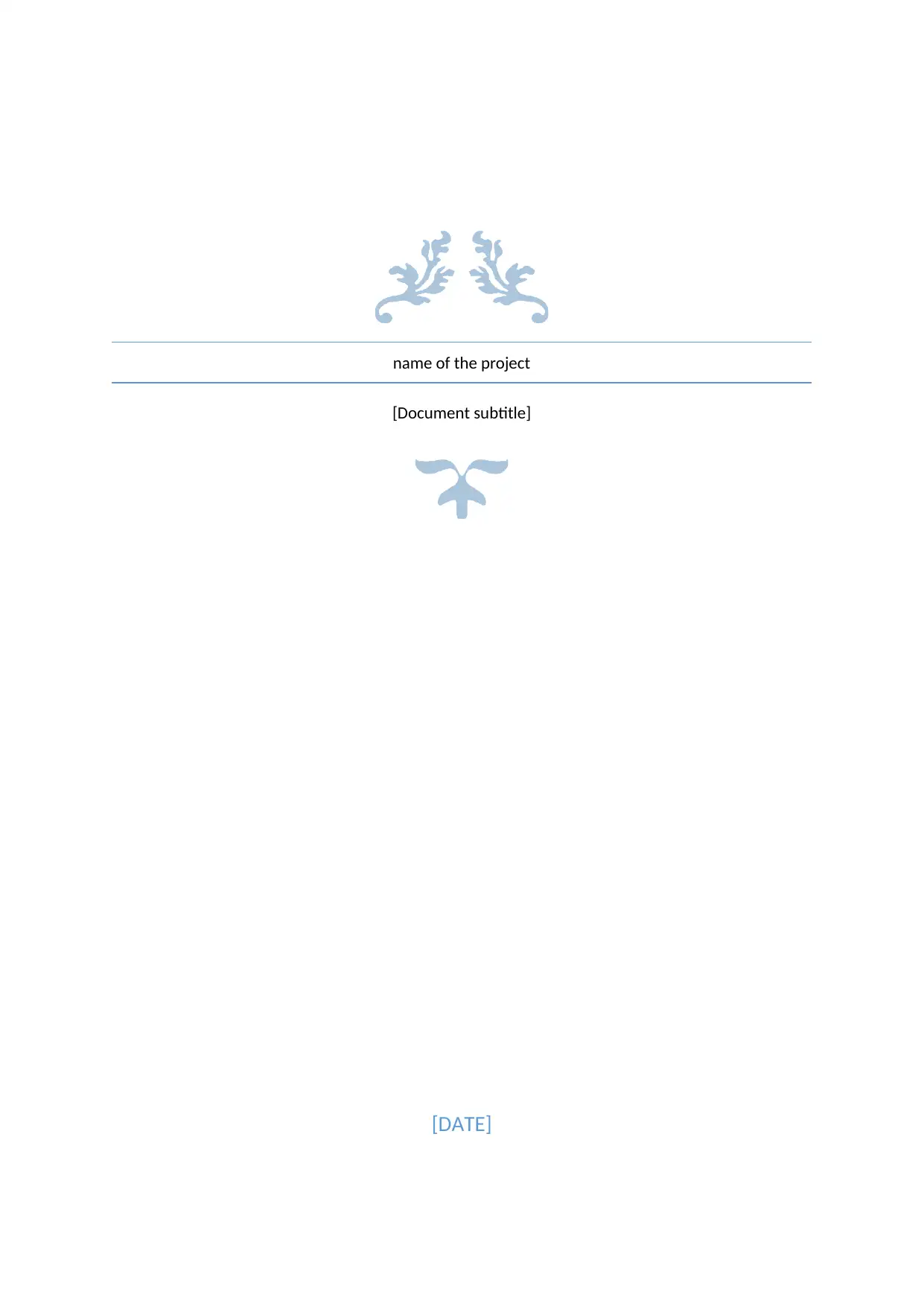
name of the project
[Document subtitle]
[DATE]
[Document subtitle]
[DATE]
Paraphrase This Document
Need a fresh take? Get an instant paraphrase of this document with our AI Paraphraser
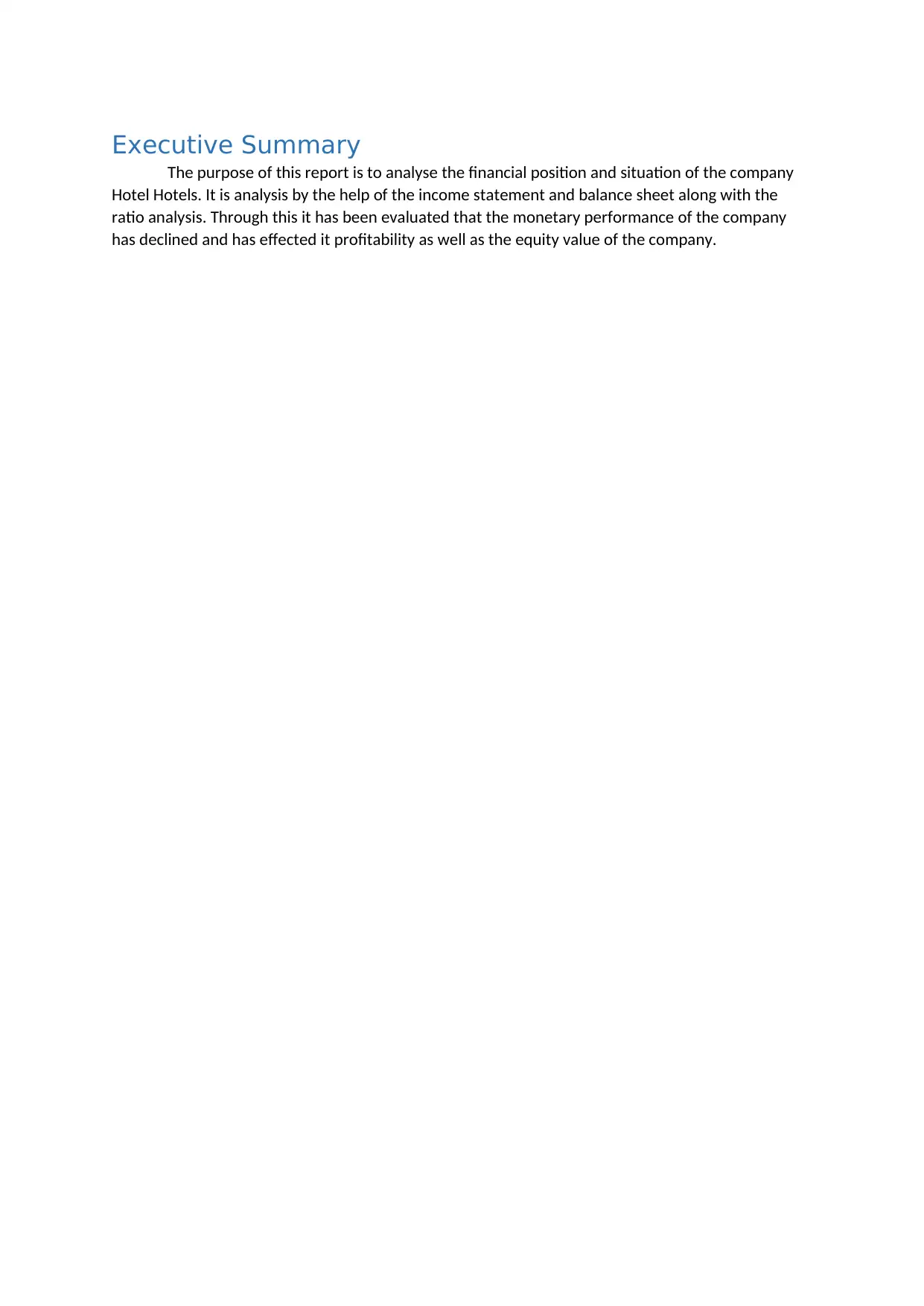
Executive Summary
The purpose of this report is to analyse the financial position and situation of the company
Hotel Hotels. It is analysis by the help of the income statement and balance sheet along with the
ratio analysis. Through this it has been evaluated that the monetary performance of the company
has declined and has effected it profitability as well as the equity value of the company.
The purpose of this report is to analyse the financial position and situation of the company
Hotel Hotels. It is analysis by the help of the income statement and balance sheet along with the
ratio analysis. Through this it has been evaluated that the monetary performance of the company
has declined and has effected it profitability as well as the equity value of the company.
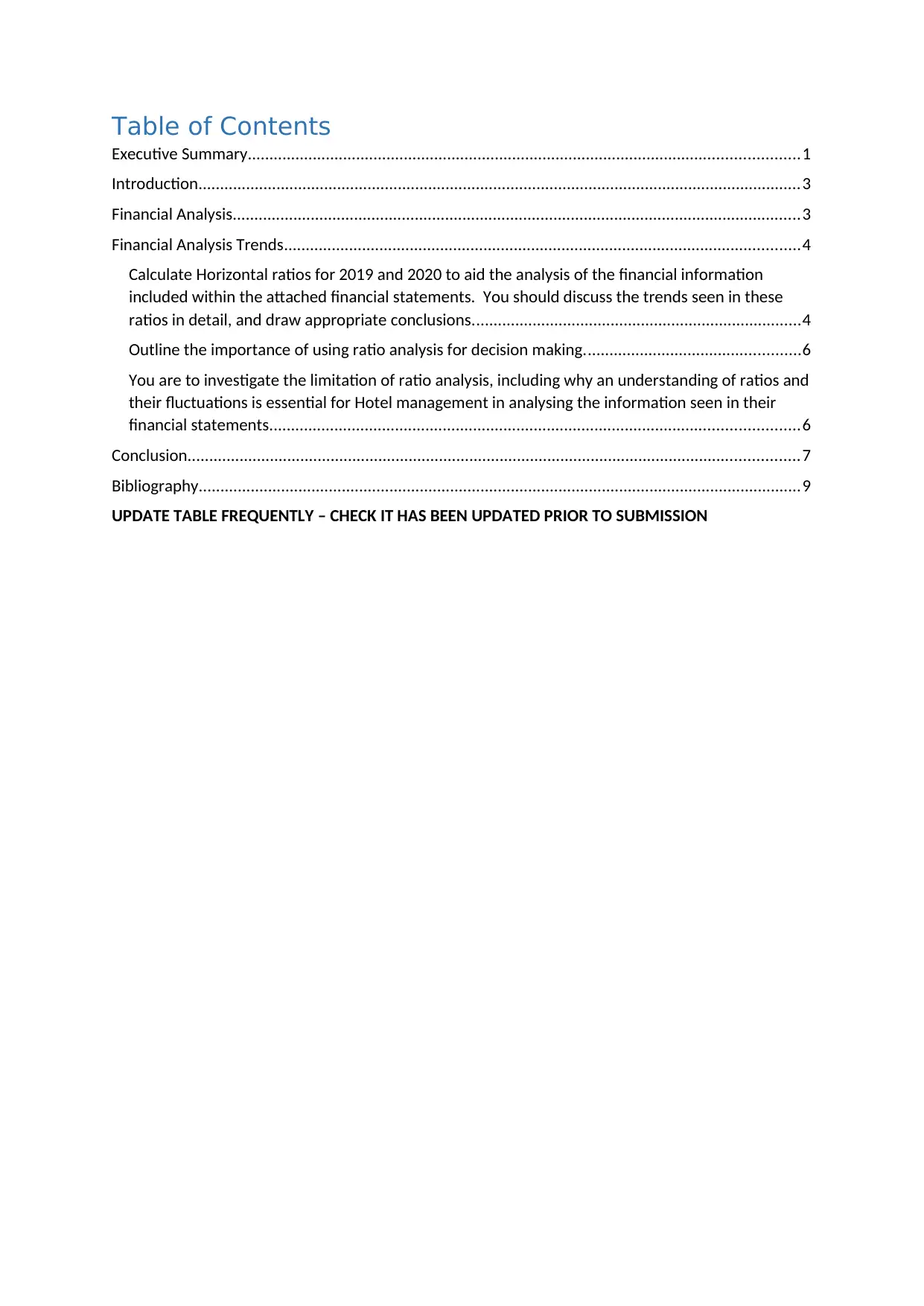
Table of Contents
Executive Summary...............................................................................................................................1
Introduction...........................................................................................................................................3
Financial Analysis...................................................................................................................................3
Financial Analysis Trends.......................................................................................................................4
Calculate Horizontal ratios for 2019 and 2020 to aid the analysis of the financial information
included within the attached financial statements. You should discuss the trends seen in these
ratios in detail, and draw appropriate conclusions............................................................................4
Outline the importance of using ratio analysis for decision making..................................................6
You are to investigate the limitation of ratio analysis, including why an understanding of ratios and
their fluctuations is essential for Hotel management in analysing the information seen in their
financial statements..........................................................................................................................6
Conclusion.............................................................................................................................................7
Bibliography...........................................................................................................................................9
UPDATE TABLE FREQUENTLY – CHECK IT HAS BEEN UPDATED PRIOR TO SUBMISSION
Executive Summary...............................................................................................................................1
Introduction...........................................................................................................................................3
Financial Analysis...................................................................................................................................3
Financial Analysis Trends.......................................................................................................................4
Calculate Horizontal ratios for 2019 and 2020 to aid the analysis of the financial information
included within the attached financial statements. You should discuss the trends seen in these
ratios in detail, and draw appropriate conclusions............................................................................4
Outline the importance of using ratio analysis for decision making..................................................6
You are to investigate the limitation of ratio analysis, including why an understanding of ratios and
their fluctuations is essential for Hotel management in analysing the information seen in their
financial statements..........................................................................................................................6
Conclusion.............................................................................................................................................7
Bibliography...........................................................................................................................................9
UPDATE TABLE FREQUENTLY – CHECK IT HAS BEEN UPDATED PRIOR TO SUBMISSION
⊘ This is a preview!⊘
Do you want full access?
Subscribe today to unlock all pages.

Trusted by 1+ million students worldwide
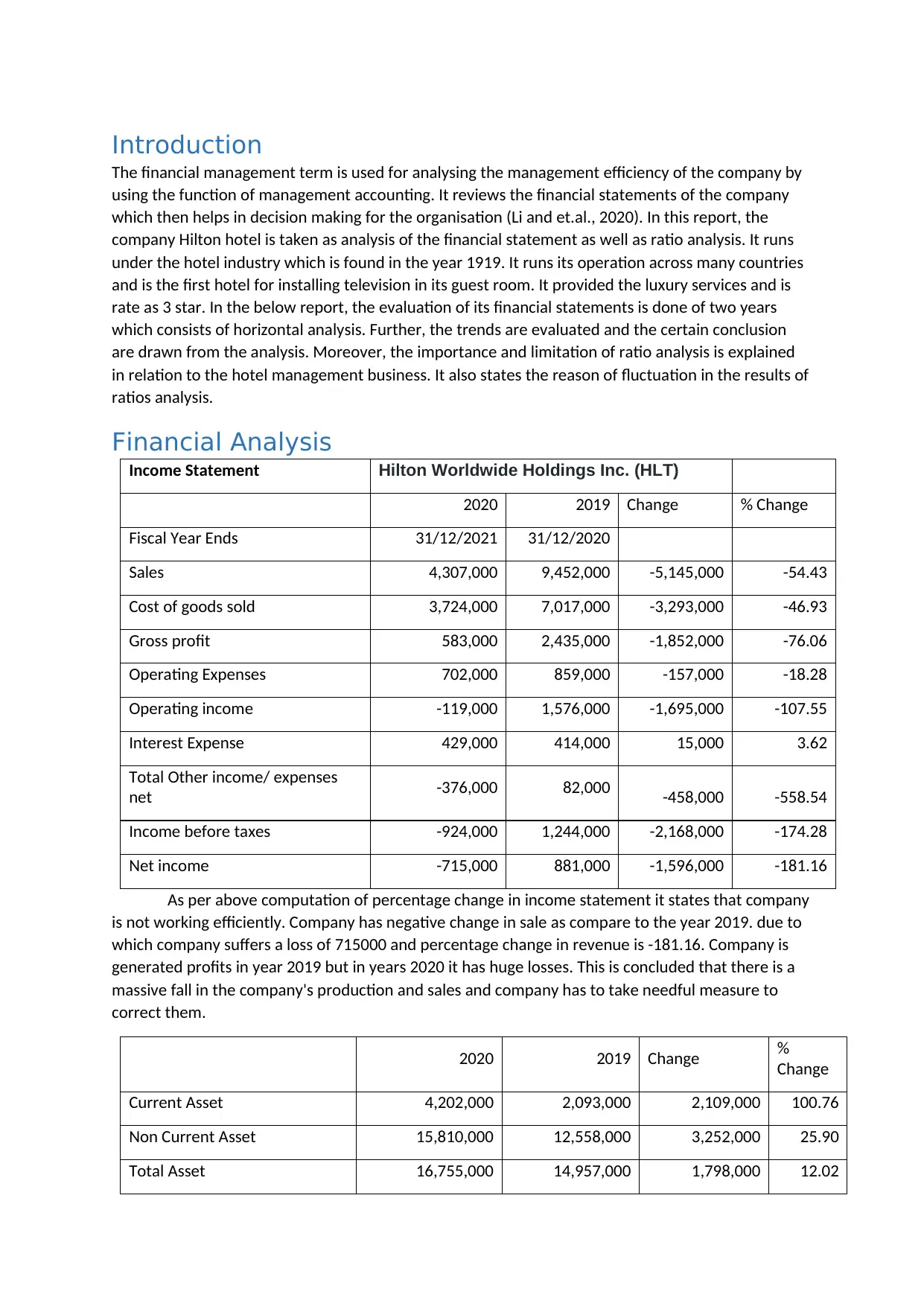
Introduction
The financial management term is used for analysing the management efficiency of the company by
using the function of management accounting. It reviews the financial statements of the company
which then helps in decision making for the organisation (Li and et.al., 2020). In this report, the
company Hilton hotel is taken as analysis of the financial statement as well as ratio analysis. It runs
under the hotel industry which is found in the year 1919. It runs its operation across many countries
and is the first hotel for installing television in its guest room. It provided the luxury services and is
rate as 3 star. In the below report, the evaluation of its financial statements is done of two years
which consists of horizontal analysis. Further, the trends are evaluated and the certain conclusion
are drawn from the analysis. Moreover, the importance and limitation of ratio analysis is explained
in relation to the hotel management business. It also states the reason of fluctuation in the results of
ratios analysis.
Financial Analysis
Income Statement Hilton Worldwide Holdings Inc. (HLT)
2020 2019 Change % Change
Fiscal Year Ends 31/12/2021 31/12/2020
Sales 4,307,000 9,452,000 -5,145,000 -54.43
Cost of goods sold 3,724,000 7,017,000 -3,293,000 -46.93
Gross profit 583,000 2,435,000 -1,852,000 -76.06
Operating Expenses 702,000 859,000 -157,000 -18.28
Operating income -119,000 1,576,000 -1,695,000 -107.55
Interest Expense 429,000 414,000 15,000 3.62
Total Other income/ expenses
net -376,000 82,000 -458,000 -558.54
Income before taxes -924,000 1,244,000 -2,168,000 -174.28
Net income -715,000 881,000 -1,596,000 -181.16
As per above computation of percentage change in income statement it states that company
is not working efficiently. Company has negative change in sale as compare to the year 2019. due to
which company suffers a loss of 715000 and percentage change in revenue is -181.16. Company is
generated profits in year 2019 but in years 2020 it has huge losses. This is concluded that there is a
massive fall in the company's production and sales and company has to take needful measure to
correct them.
2020 2019 Change %
Change
Current Asset 4,202,000 2,093,000 2,109,000 100.76
Non Current Asset 15,810,000 12,558,000 3,252,000 25.90
Total Asset 16,755,000 14,957,000 1,798,000 12.02
The financial management term is used for analysing the management efficiency of the company by
using the function of management accounting. It reviews the financial statements of the company
which then helps in decision making for the organisation (Li and et.al., 2020). In this report, the
company Hilton hotel is taken as analysis of the financial statement as well as ratio analysis. It runs
under the hotel industry which is found in the year 1919. It runs its operation across many countries
and is the first hotel for installing television in its guest room. It provided the luxury services and is
rate as 3 star. In the below report, the evaluation of its financial statements is done of two years
which consists of horizontal analysis. Further, the trends are evaluated and the certain conclusion
are drawn from the analysis. Moreover, the importance and limitation of ratio analysis is explained
in relation to the hotel management business. It also states the reason of fluctuation in the results of
ratios analysis.
Financial Analysis
Income Statement Hilton Worldwide Holdings Inc. (HLT)
2020 2019 Change % Change
Fiscal Year Ends 31/12/2021 31/12/2020
Sales 4,307,000 9,452,000 -5,145,000 -54.43
Cost of goods sold 3,724,000 7,017,000 -3,293,000 -46.93
Gross profit 583,000 2,435,000 -1,852,000 -76.06
Operating Expenses 702,000 859,000 -157,000 -18.28
Operating income -119,000 1,576,000 -1,695,000 -107.55
Interest Expense 429,000 414,000 15,000 3.62
Total Other income/ expenses
net -376,000 82,000 -458,000 -558.54
Income before taxes -924,000 1,244,000 -2,168,000 -174.28
Net income -715,000 881,000 -1,596,000 -181.16
As per above computation of percentage change in income statement it states that company
is not working efficiently. Company has negative change in sale as compare to the year 2019. due to
which company suffers a loss of 715000 and percentage change in revenue is -181.16. Company is
generated profits in year 2019 but in years 2020 it has huge losses. This is concluded that there is a
massive fall in the company's production and sales and company has to take needful measure to
correct them.
2020 2019 Change %
Change
Current Asset 4,202,000 2,093,000 2,109,000 100.76
Non Current Asset 15,810,000 12,558,000 3,252,000 25.90
Total Asset 16,755,000 14,957,000 1,798,000 12.02
Paraphrase This Document
Need a fresh take? Get an instant paraphrase of this document with our AI Paraphraser
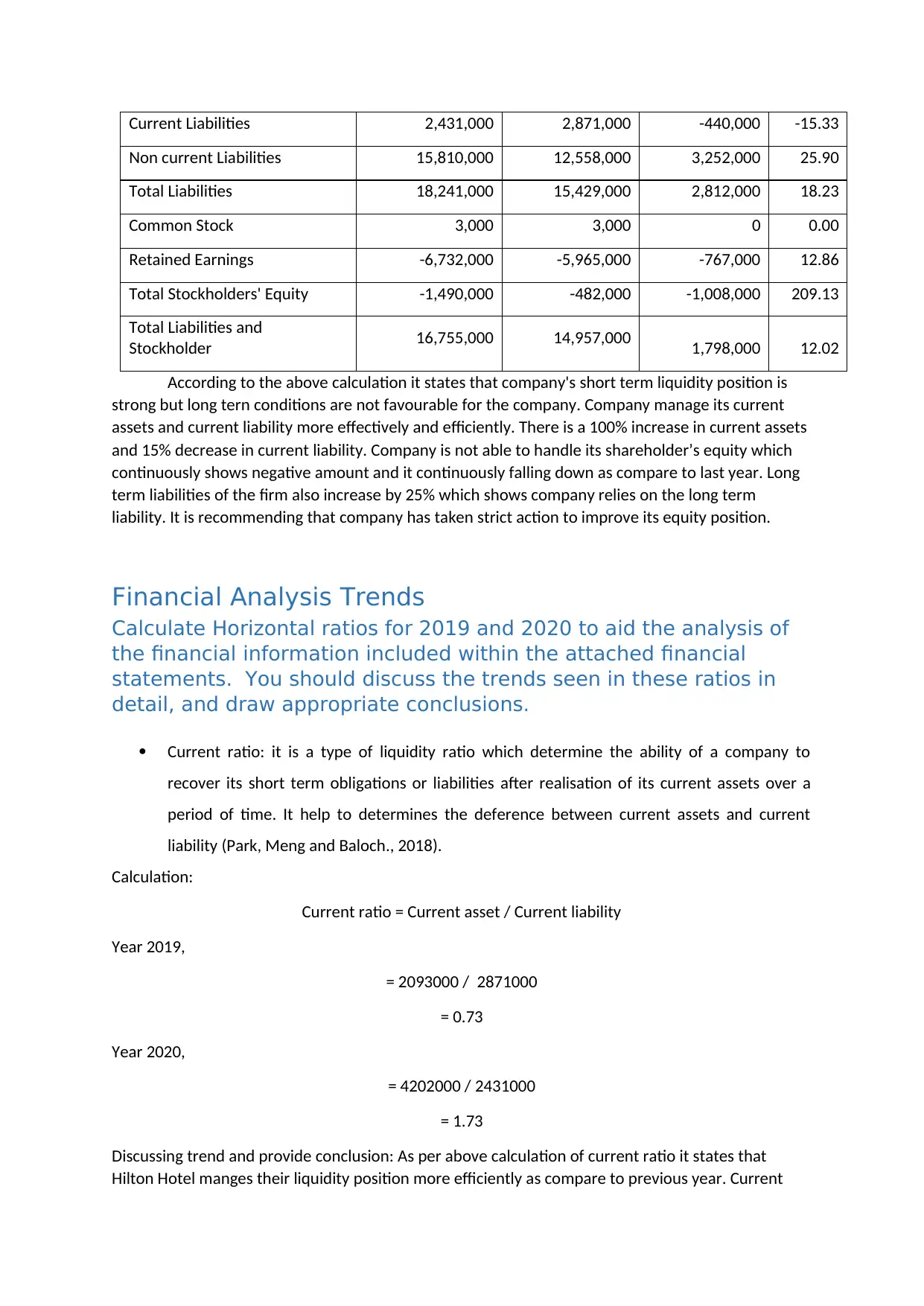
Current Liabilities 2,431,000 2,871,000 -440,000 -15.33
Non current Liabilities 15,810,000 12,558,000 3,252,000 25.90
Total Liabilities 18,241,000 15,429,000 2,812,000 18.23
Common Stock 3,000 3,000 0 0.00
Retained Earnings -6,732,000 -5,965,000 -767,000 12.86
Total Stockholders' Equity -1,490,000 -482,000 -1,008,000 209.13
Total Liabilities and
Stockholder 16,755,000 14,957,000 1,798,000 12.02
According to the above calculation it states that company's short term liquidity position is
strong but long tern conditions are not favourable for the company. Company manage its current
assets and current liability more effectively and efficiently. There is a 100% increase in current assets
and 15% decrease in current liability. Company is not able to handle its shareholder’s equity which
continuously shows negative amount and it continuously falling down as compare to last year. Long
term liabilities of the firm also increase by 25% which shows company relies on the long term
liability. It is recommending that company has taken strict action to improve its equity position.
Financial Analysis Trends
Calculate Horizontal ratios for 2019 and 2020 to aid the analysis of
the financial information included within the attached financial
statements. You should discuss the trends seen in these ratios in
detail, and draw appropriate conclusions.
Current ratio: it is a type of liquidity ratio which determine the ability of a company to
recover its short term obligations or liabilities after realisation of its current assets over a
period of time. It help to determines the deference between current assets and current
liability (Park, Meng and Baloch., 2018).
Calculation:
Current ratio = Current asset / Current liability
Year 2019,
= 2093000 / 2871000
= 0.73
Year 2020,
= 4202000 / 2431000
= 1.73
Discussing trend and provide conclusion: As per above calculation of current ratio it states that
Hilton Hotel manges their liquidity position more efficiently as compare to previous year. Current
Non current Liabilities 15,810,000 12,558,000 3,252,000 25.90
Total Liabilities 18,241,000 15,429,000 2,812,000 18.23
Common Stock 3,000 3,000 0 0.00
Retained Earnings -6,732,000 -5,965,000 -767,000 12.86
Total Stockholders' Equity -1,490,000 -482,000 -1,008,000 209.13
Total Liabilities and
Stockholder 16,755,000 14,957,000 1,798,000 12.02
According to the above calculation it states that company's short term liquidity position is
strong but long tern conditions are not favourable for the company. Company manage its current
assets and current liability more effectively and efficiently. There is a 100% increase in current assets
and 15% decrease in current liability. Company is not able to handle its shareholder’s equity which
continuously shows negative amount and it continuously falling down as compare to last year. Long
term liabilities of the firm also increase by 25% which shows company relies on the long term
liability. It is recommending that company has taken strict action to improve its equity position.
Financial Analysis Trends
Calculate Horizontal ratios for 2019 and 2020 to aid the analysis of
the financial information included within the attached financial
statements. You should discuss the trends seen in these ratios in
detail, and draw appropriate conclusions.
Current ratio: it is a type of liquidity ratio which determine the ability of a company to
recover its short term obligations or liabilities after realisation of its current assets over a
period of time. It help to determines the deference between current assets and current
liability (Park, Meng and Baloch., 2018).
Calculation:
Current ratio = Current asset / Current liability
Year 2019,
= 2093000 / 2871000
= 0.73
Year 2020,
= 4202000 / 2431000
= 1.73
Discussing trend and provide conclusion: As per above calculation of current ratio it states that
Hilton Hotel manges their liquidity position more efficiently as compare to previous year. Current
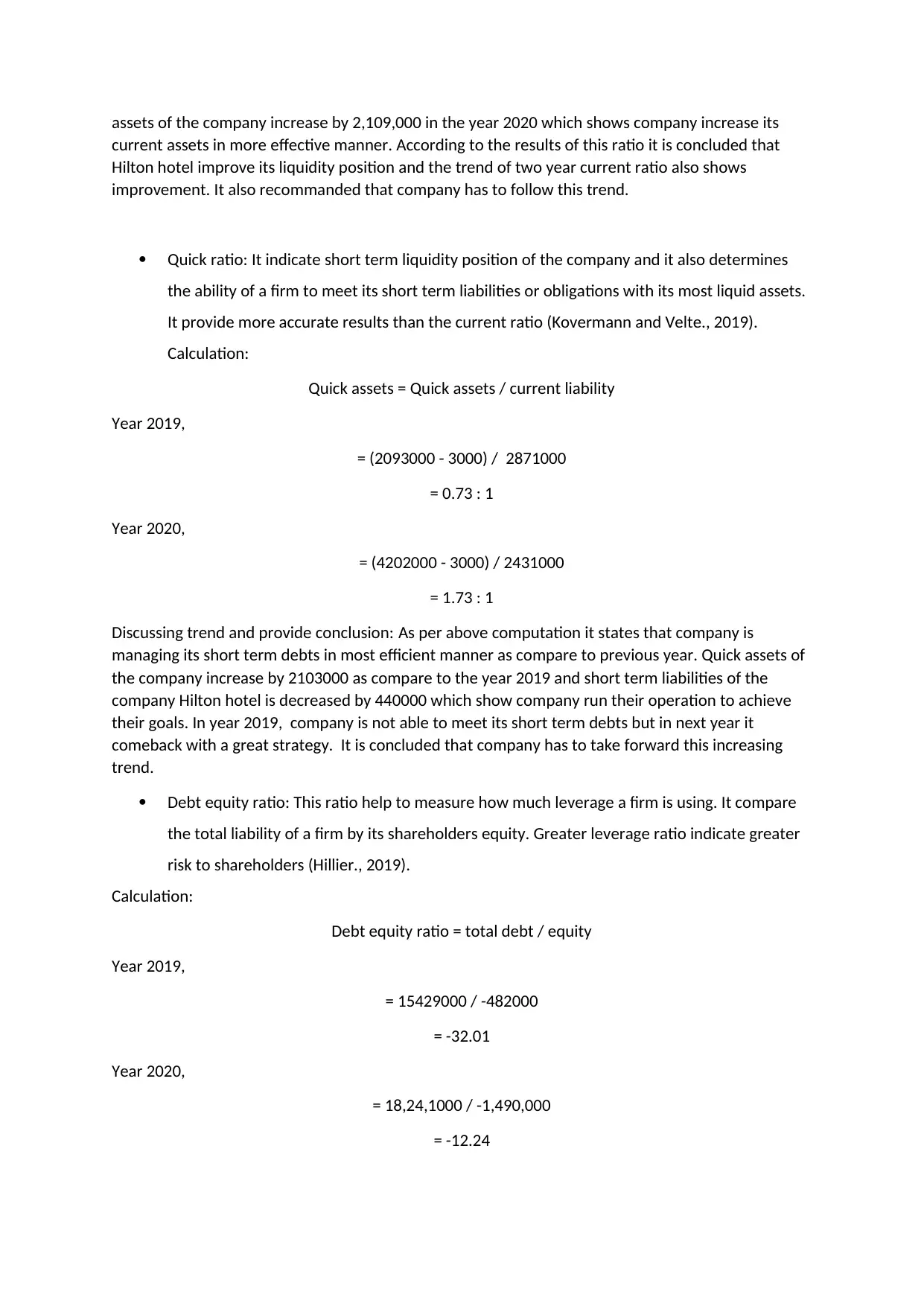
assets of the company increase by 2,109,000 in the year 2020 which shows company increase its
current assets in more effective manner. According to the results of this ratio it is concluded that
Hilton hotel improve its liquidity position and the trend of two year current ratio also shows
improvement. It also recommanded that company has to follow this trend.
Quick ratio: It indicate short term liquidity position of the company and it also determines
the ability of a firm to meet its short term liabilities or obligations with its most liquid assets.
It provide more accurate results than the current ratio (Kovermann and Velte., 2019).
Calculation:
Quick assets = Quick assets / current liability
Year 2019,
= (2093000 - 3000) / 2871000
= 0.73 : 1
Year 2020,
= (4202000 - 3000) / 2431000
= 1.73 : 1
Discussing trend and provide conclusion: As per above computation it states that company is
managing its short term debts in most efficient manner as compare to previous year. Quick assets of
the company increase by 2103000 as compare to the year 2019 and short term liabilities of the
company Hilton hotel is decreased by 440000 which show company run their operation to achieve
their goals. In year 2019, company is not able to meet its short term debts but in next year it
comeback with a great strategy. It is concluded that company has to take forward this increasing
trend.
Debt equity ratio: This ratio help to measure how much leverage a firm is using. It compare
the total liability of a firm by its shareholders equity. Greater leverage ratio indicate greater
risk to shareholders (Hillier., 2019).
Calculation:
Debt equity ratio = total debt / equity
Year 2019,
= 15429000 / -482000
= -32.01
Year 2020,
= 18,24,1000 / -1,490,000
= -12.24
current assets in more effective manner. According to the results of this ratio it is concluded that
Hilton hotel improve its liquidity position and the trend of two year current ratio also shows
improvement. It also recommanded that company has to follow this trend.
Quick ratio: It indicate short term liquidity position of the company and it also determines
the ability of a firm to meet its short term liabilities or obligations with its most liquid assets.
It provide more accurate results than the current ratio (Kovermann and Velte., 2019).
Calculation:
Quick assets = Quick assets / current liability
Year 2019,
= (2093000 - 3000) / 2871000
= 0.73 : 1
Year 2020,
= (4202000 - 3000) / 2431000
= 1.73 : 1
Discussing trend and provide conclusion: As per above computation it states that company is
managing its short term debts in most efficient manner as compare to previous year. Quick assets of
the company increase by 2103000 as compare to the year 2019 and short term liabilities of the
company Hilton hotel is decreased by 440000 which show company run their operation to achieve
their goals. In year 2019, company is not able to meet its short term debts but in next year it
comeback with a great strategy. It is concluded that company has to take forward this increasing
trend.
Debt equity ratio: This ratio help to measure how much leverage a firm is using. It compare
the total liability of a firm by its shareholders equity. Greater leverage ratio indicate greater
risk to shareholders (Hillier., 2019).
Calculation:
Debt equity ratio = total debt / equity
Year 2019,
= 15429000 / -482000
= -32.01
Year 2020,
= 18,24,1000 / -1,490,000
= -12.24
⊘ This is a preview!⊘
Do you want full access?
Subscribe today to unlock all pages.

Trusted by 1+ million students worldwide
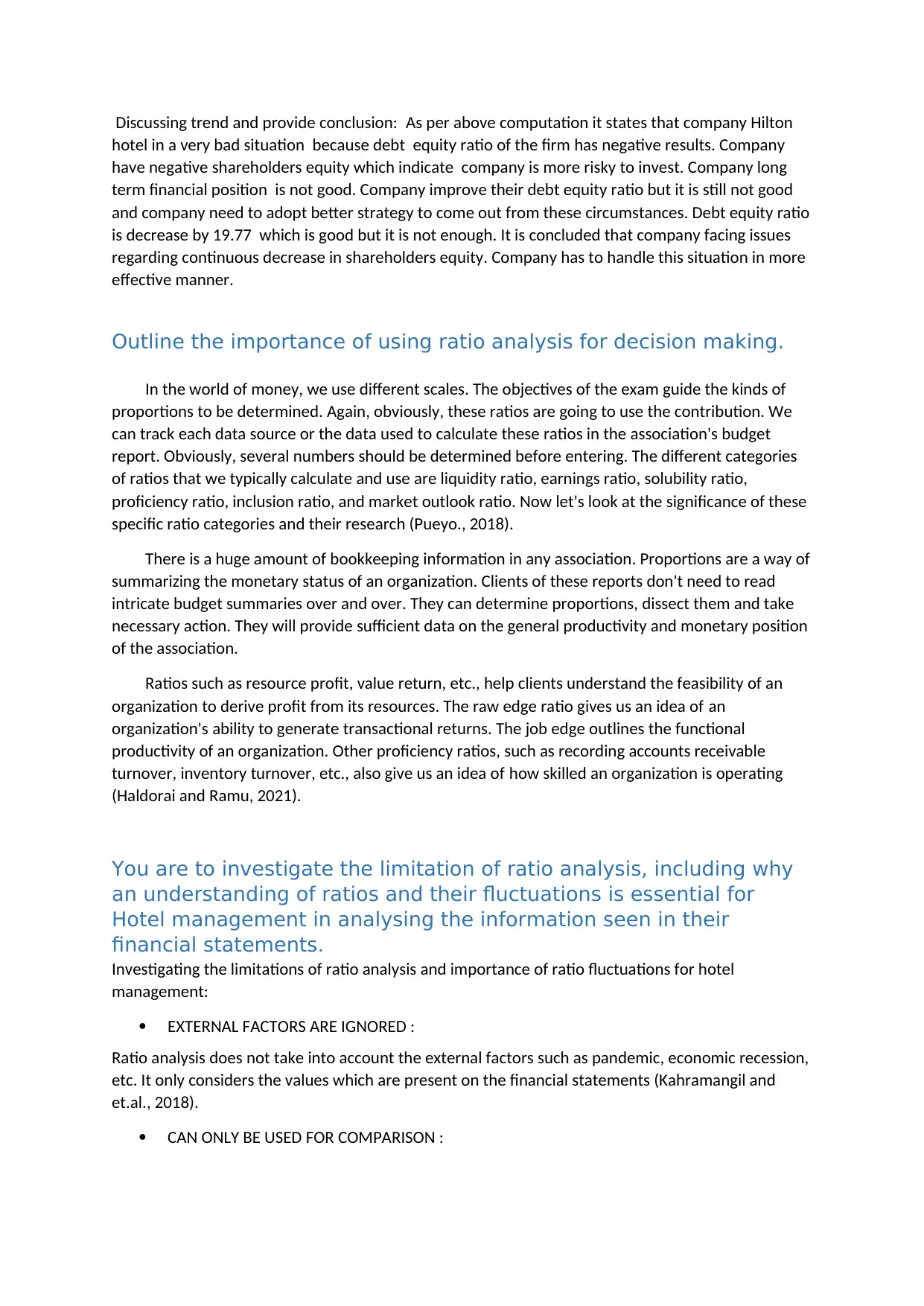
Discussing trend and provide conclusion: As per above computation it states that company Hilton
hotel in a very bad situation because debt equity ratio of the firm has negative results. Company
have negative shareholders equity which indicate company is more risky to invest. Company long
term financial position is not good. Company improve their debt equity ratio but it is still not good
and company need to adopt better strategy to come out from these circumstances. Debt equity ratio
is decrease by 19.77 which is good but it is not enough. It is concluded that company facing issues
regarding continuous decrease in shareholders equity. Company has to handle this situation in more
effective manner.
Outline the importance of using ratio analysis for decision making.
In the world of money, we use different scales. The objectives of the exam guide the kinds of
proportions to be determined. Again, obviously, these ratios are going to use the contribution. We
can track each data source or the data used to calculate these ratios in the association's budget
report. Obviously, several numbers should be determined before entering. The different categories
of ratios that we typically calculate and use are liquidity ratio, earnings ratio, solubility ratio,
proficiency ratio, inclusion ratio, and market outlook ratio. Now let's look at the significance of these
specific ratio categories and their research (Pueyo., 2018).
There is a huge amount of bookkeeping information in any association. Proportions are a way of
summarizing the monetary status of an organization. Clients of these reports don't need to read
intricate budget summaries over and over. They can determine proportions, dissect them and take
necessary action. They will provide sufficient data on the general productivity and monetary position
of the association.
Ratios such as resource profit, value return, etc., help clients understand the feasibility of an
organization to derive profit from its resources. The raw edge ratio gives us an idea of an
organization's ability to generate transactional returns. The job edge outlines the functional
productivity of an organization. Other proficiency ratios, such as recording accounts receivable
turnover, inventory turnover, etc., also give us an idea of how skilled an organization is operating
(Haldorai and Ramu, 2021).
You are to investigate the limitation of ratio analysis, including why
an understanding of ratios and their fluctuations is essential for
Hotel management in analysing the information seen in their
financial statements.
Investigating the limitations of ratio analysis and importance of ratio fluctuations for hotel
management:
EXTERNAL FACTORS ARE IGNORED :
Ratio analysis does not take into account the external factors such as pandemic, economic recession,
etc. It only considers the values which are present on the financial statements (Kahramangil and
et.al., 2018).
CAN ONLY BE USED FOR COMPARISON :
hotel in a very bad situation because debt equity ratio of the firm has negative results. Company
have negative shareholders equity which indicate company is more risky to invest. Company long
term financial position is not good. Company improve their debt equity ratio but it is still not good
and company need to adopt better strategy to come out from these circumstances. Debt equity ratio
is decrease by 19.77 which is good but it is not enough. It is concluded that company facing issues
regarding continuous decrease in shareholders equity. Company has to handle this situation in more
effective manner.
Outline the importance of using ratio analysis for decision making.
In the world of money, we use different scales. The objectives of the exam guide the kinds of
proportions to be determined. Again, obviously, these ratios are going to use the contribution. We
can track each data source or the data used to calculate these ratios in the association's budget
report. Obviously, several numbers should be determined before entering. The different categories
of ratios that we typically calculate and use are liquidity ratio, earnings ratio, solubility ratio,
proficiency ratio, inclusion ratio, and market outlook ratio. Now let's look at the significance of these
specific ratio categories and their research (Pueyo., 2018).
There is a huge amount of bookkeeping information in any association. Proportions are a way of
summarizing the monetary status of an organization. Clients of these reports don't need to read
intricate budget summaries over and over. They can determine proportions, dissect them and take
necessary action. They will provide sufficient data on the general productivity and monetary position
of the association.
Ratios such as resource profit, value return, etc., help clients understand the feasibility of an
organization to derive profit from its resources. The raw edge ratio gives us an idea of an
organization's ability to generate transactional returns. The job edge outlines the functional
productivity of an organization. Other proficiency ratios, such as recording accounts receivable
turnover, inventory turnover, etc., also give us an idea of how skilled an organization is operating
(Haldorai and Ramu, 2021).
You are to investigate the limitation of ratio analysis, including why
an understanding of ratios and their fluctuations is essential for
Hotel management in analysing the information seen in their
financial statements.
Investigating the limitations of ratio analysis and importance of ratio fluctuations for hotel
management:
EXTERNAL FACTORS ARE IGNORED :
Ratio analysis does not take into account the external factors such as pandemic, economic recession,
etc. It only considers the values which are present on the financial statements (Kahramangil and
et.al., 2018).
CAN ONLY BE USED FOR COMPARISON :
Paraphrase This Document
Need a fresh take? Get an instant paraphrase of this document with our AI Paraphraser
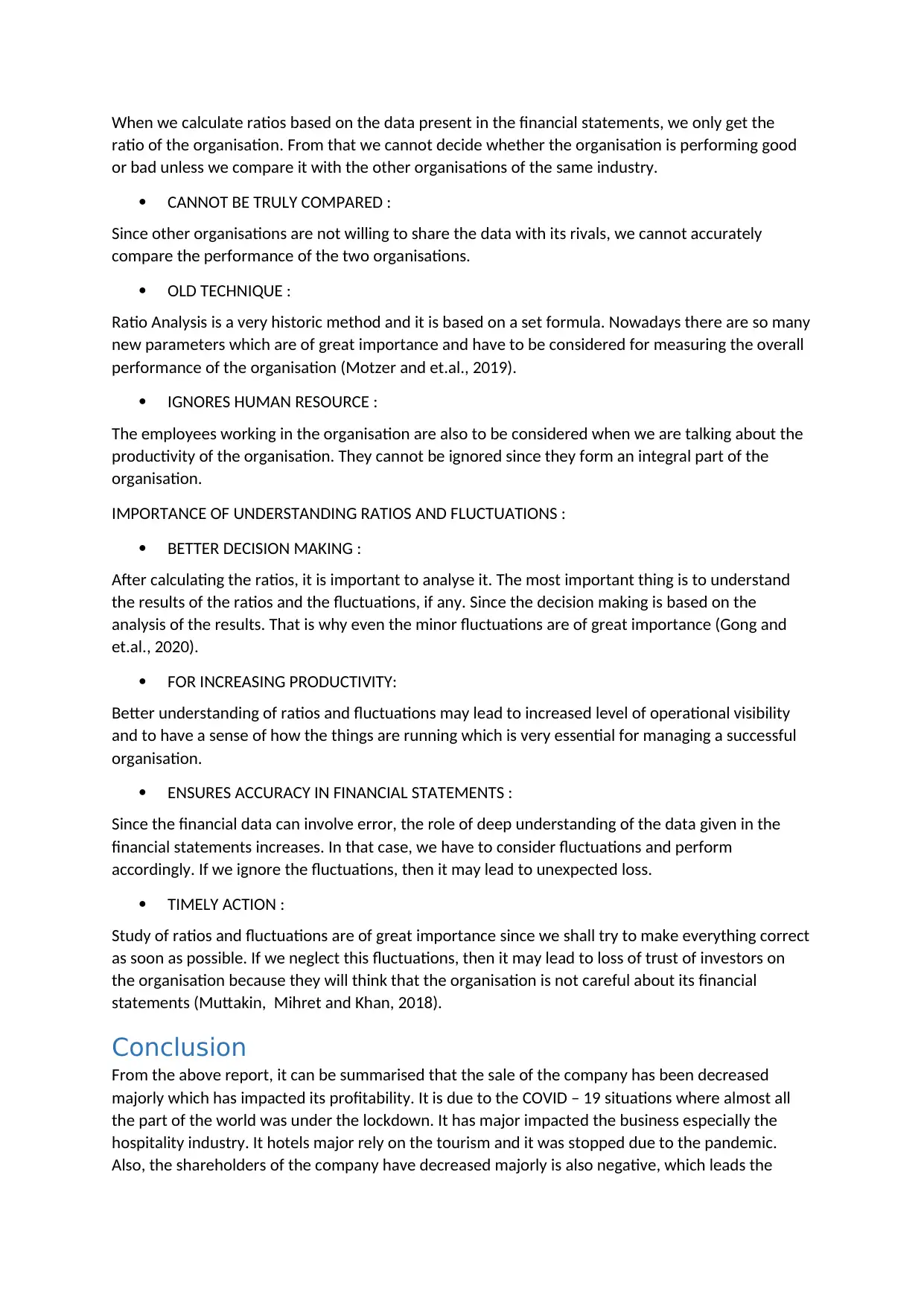
When we calculate ratios based on the data present in the financial statements, we only get the
ratio of the organisation. From that we cannot decide whether the organisation is performing good
or bad unless we compare it with the other organisations of the same industry.
CANNOT BE TRULY COMPARED :
Since other organisations are not willing to share the data with its rivals, we cannot accurately
compare the performance of the two organisations.
OLD TECHNIQUE :
Ratio Analysis is a very historic method and it is based on a set formula. Nowadays there are so many
new parameters which are of great importance and have to be considered for measuring the overall
performance of the organisation (Motzer and et.al., 2019).
IGNORES HUMAN RESOURCE :
The employees working in the organisation are also to be considered when we are talking about the
productivity of the organisation. They cannot be ignored since they form an integral part of the
organisation.
IMPORTANCE OF UNDERSTANDING RATIOS AND FLUCTUATIONS :
BETTER DECISION MAKING :
After calculating the ratios, it is important to analyse it. The most important thing is to understand
the results of the ratios and the fluctuations, if any. Since the decision making is based on the
analysis of the results. That is why even the minor fluctuations are of great importance (Gong and
et.al., 2020).
FOR INCREASING PRODUCTIVITY:
Better understanding of ratios and fluctuations may lead to increased level of operational visibility
and to have a sense of how the things are running which is very essential for managing a successful
organisation.
ENSURES ACCURACY IN FINANCIAL STATEMENTS :
Since the financial data can involve error, the role of deep understanding of the data given in the
financial statements increases. In that case, we have to consider fluctuations and perform
accordingly. If we ignore the fluctuations, then it may lead to unexpected loss.
TIMELY ACTION :
Study of ratios and fluctuations are of great importance since we shall try to make everything correct
as soon as possible. If we neglect this fluctuations, then it may lead to loss of trust of investors on
the organisation because they will think that the organisation is not careful about its financial
statements (Muttakin, Mihret and Khan, 2018).
Conclusion
From the above report, it can be summarised that the sale of the company has been decreased
majorly which has impacted its profitability. It is due to the COVID – 19 situations where almost all
the part of the world was under the lockdown. It has major impacted the business especially the
hospitality industry. It hotels major rely on the tourism and it was stopped due to the pandemic.
Also, the shareholders of the company have decreased majorly is also negative, which leads the
ratio of the organisation. From that we cannot decide whether the organisation is performing good
or bad unless we compare it with the other organisations of the same industry.
CANNOT BE TRULY COMPARED :
Since other organisations are not willing to share the data with its rivals, we cannot accurately
compare the performance of the two organisations.
OLD TECHNIQUE :
Ratio Analysis is a very historic method and it is based on a set formula. Nowadays there are so many
new parameters which are of great importance and have to be considered for measuring the overall
performance of the organisation (Motzer and et.al., 2019).
IGNORES HUMAN RESOURCE :
The employees working in the organisation are also to be considered when we are talking about the
productivity of the organisation. They cannot be ignored since they form an integral part of the
organisation.
IMPORTANCE OF UNDERSTANDING RATIOS AND FLUCTUATIONS :
BETTER DECISION MAKING :
After calculating the ratios, it is important to analyse it. The most important thing is to understand
the results of the ratios and the fluctuations, if any. Since the decision making is based on the
analysis of the results. That is why even the minor fluctuations are of great importance (Gong and
et.al., 2020).
FOR INCREASING PRODUCTIVITY:
Better understanding of ratios and fluctuations may lead to increased level of operational visibility
and to have a sense of how the things are running which is very essential for managing a successful
organisation.
ENSURES ACCURACY IN FINANCIAL STATEMENTS :
Since the financial data can involve error, the role of deep understanding of the data given in the
financial statements increases. In that case, we have to consider fluctuations and perform
accordingly. If we ignore the fluctuations, then it may lead to unexpected loss.
TIMELY ACTION :
Study of ratios and fluctuations are of great importance since we shall try to make everything correct
as soon as possible. If we neglect this fluctuations, then it may lead to loss of trust of investors on
the organisation because they will think that the organisation is not careful about its financial
statements (Muttakin, Mihret and Khan, 2018).
Conclusion
From the above report, it can be summarised that the sale of the company has been decreased
majorly which has impacted its profitability. It is due to the COVID – 19 situations where almost all
the part of the world was under the lockdown. It has major impacted the business especially the
hospitality industry. It hotels major rely on the tourism and it was stopped due to the pandemic.
Also, the shareholders of the company have decreased majorly is also negative, which leads the
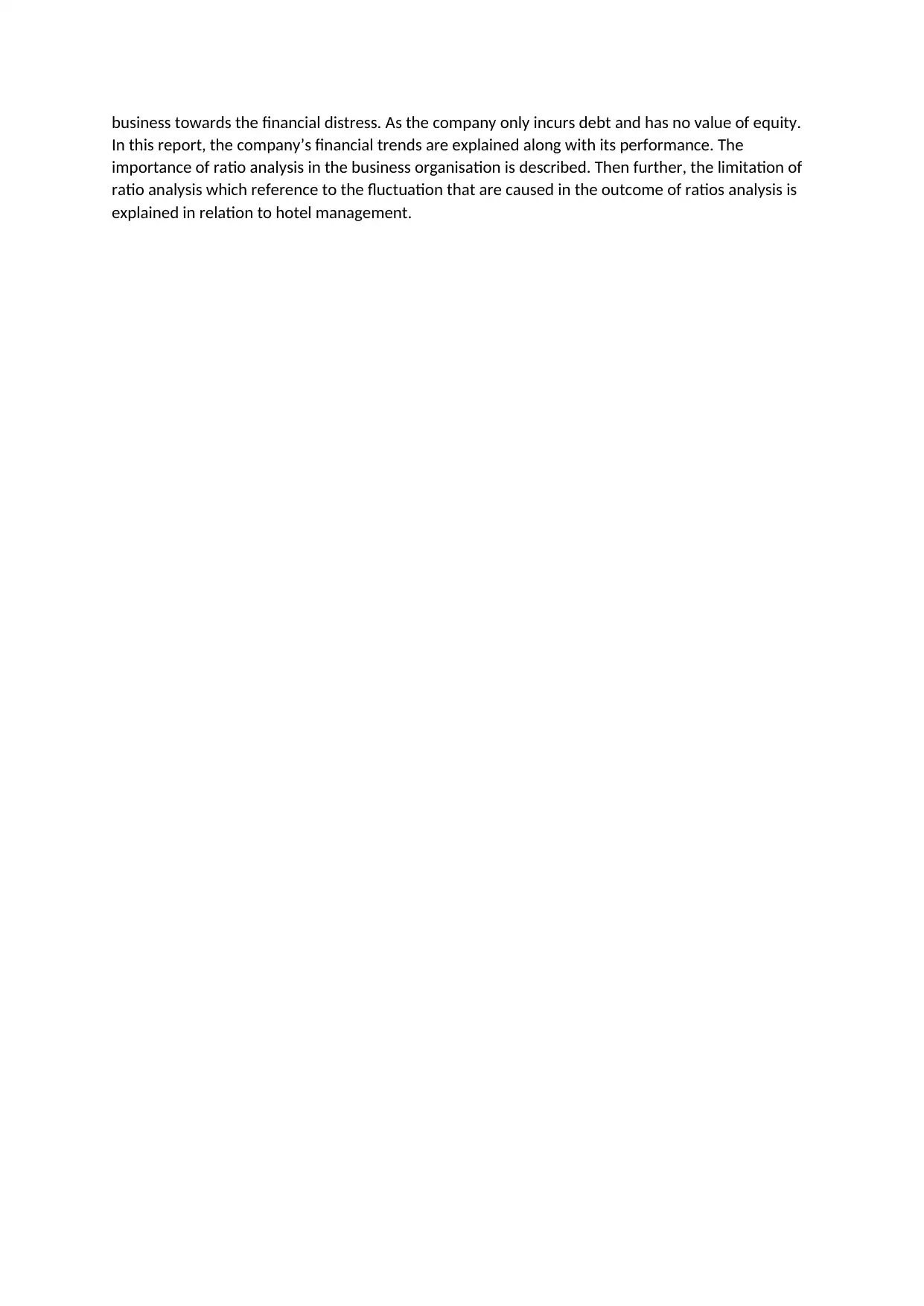
business towards the financial distress. As the company only incurs debt and has no value of equity.
In this report, the company’s financial trends are explained along with its performance. The
importance of ratio analysis in the business organisation is described. Then further, the limitation of
ratio analysis which reference to the fluctuation that are caused in the outcome of ratios analysis is
explained in relation to hotel management.
In this report, the company’s financial trends are explained along with its performance. The
importance of ratio analysis in the business organisation is described. Then further, the limitation of
ratio analysis which reference to the fluctuation that are caused in the outcome of ratios analysis is
explained in relation to hotel management.
⊘ This is a preview!⊘
Do you want full access?
Subscribe today to unlock all pages.

Trusted by 1+ million students worldwide
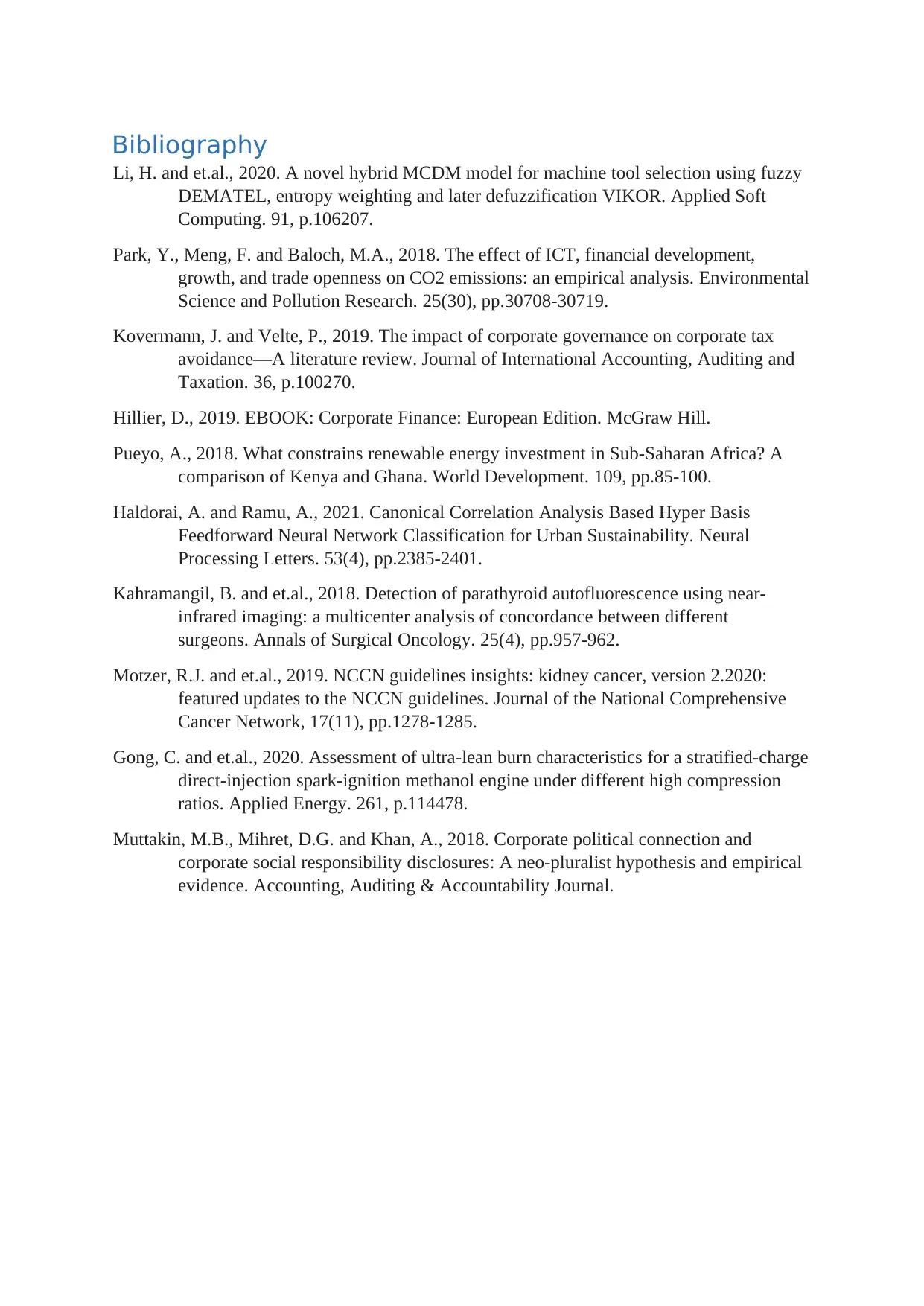
Bibliography
Li, H. and et.al., 2020. A novel hybrid MCDM model for machine tool selection using fuzzy
DEMATEL, entropy weighting and later defuzzification VIKOR. Applied Soft
Computing. 91, p.106207.
Park, Y., Meng, F. and Baloch, M.A., 2018. The effect of ICT, financial development,
growth, and trade openness on CO2 emissions: an empirical analysis. Environmental
Science and Pollution Research. 25(30), pp.30708-30719.
Kovermann, J. and Velte, P., 2019. The impact of corporate governance on corporate tax
avoidance—A literature review. Journal of International Accounting, Auditing and
Taxation. 36, p.100270.
Hillier, D., 2019. EBOOK: Corporate Finance: European Edition. McGraw Hill.
Pueyo, A., 2018. What constrains renewable energy investment in Sub-Saharan Africa? A
comparison of Kenya and Ghana. World Development. 109, pp.85-100.
Haldorai, A. and Ramu, A., 2021. Canonical Correlation Analysis Based Hyper Basis
Feedforward Neural Network Classification for Urban Sustainability. Neural
Processing Letters. 53(4), pp.2385-2401.
Kahramangil, B. and et.al., 2018. Detection of parathyroid autofluorescence using near-
infrared imaging: a multicenter analysis of concordance between different
surgeons. Annals of Surgical Oncology. 25(4), pp.957-962.
Motzer, R.J. and et.al., 2019. NCCN guidelines insights: kidney cancer, version 2.2020:
featured updates to the NCCN guidelines. Journal of the National Comprehensive
Cancer Network, 17(11), pp.1278-1285.
Gong, C. and et.al., 2020. Assessment of ultra-lean burn characteristics for a stratified-charge
direct-injection spark-ignition methanol engine under different high compression
ratios. Applied Energy. 261, p.114478.
Muttakin, M.B., Mihret, D.G. and Khan, A., 2018. Corporate political connection and
corporate social responsibility disclosures: A neo-pluralist hypothesis and empirical
evidence. Accounting, Auditing & Accountability Journal.
Li, H. and et.al., 2020. A novel hybrid MCDM model for machine tool selection using fuzzy
DEMATEL, entropy weighting and later defuzzification VIKOR. Applied Soft
Computing. 91, p.106207.
Park, Y., Meng, F. and Baloch, M.A., 2018. The effect of ICT, financial development,
growth, and trade openness on CO2 emissions: an empirical analysis. Environmental
Science and Pollution Research. 25(30), pp.30708-30719.
Kovermann, J. and Velte, P., 2019. The impact of corporate governance on corporate tax
avoidance—A literature review. Journal of International Accounting, Auditing and
Taxation. 36, p.100270.
Hillier, D., 2019. EBOOK: Corporate Finance: European Edition. McGraw Hill.
Pueyo, A., 2018. What constrains renewable energy investment in Sub-Saharan Africa? A
comparison of Kenya and Ghana. World Development. 109, pp.85-100.
Haldorai, A. and Ramu, A., 2021. Canonical Correlation Analysis Based Hyper Basis
Feedforward Neural Network Classification for Urban Sustainability. Neural
Processing Letters. 53(4), pp.2385-2401.
Kahramangil, B. and et.al., 2018. Detection of parathyroid autofluorescence using near-
infrared imaging: a multicenter analysis of concordance between different
surgeons. Annals of Surgical Oncology. 25(4), pp.957-962.
Motzer, R.J. and et.al., 2019. NCCN guidelines insights: kidney cancer, version 2.2020:
featured updates to the NCCN guidelines. Journal of the National Comprehensive
Cancer Network, 17(11), pp.1278-1285.
Gong, C. and et.al., 2020. Assessment of ultra-lean burn characteristics for a stratified-charge
direct-injection spark-ignition methanol engine under different high compression
ratios. Applied Energy. 261, p.114478.
Muttakin, M.B., Mihret, D.G. and Khan, A., 2018. Corporate political connection and
corporate social responsibility disclosures: A neo-pluralist hypothesis and empirical
evidence. Accounting, Auditing & Accountability Journal.
1 out of 10
Related Documents
Your All-in-One AI-Powered Toolkit for Academic Success.
+13062052269
info@desklib.com
Available 24*7 on WhatsApp / Email
![[object Object]](/_next/static/media/star-bottom.7253800d.svg)
Unlock your academic potential
Copyright © 2020–2025 A2Z Services. All Rights Reserved. Developed and managed by ZUCOL.




